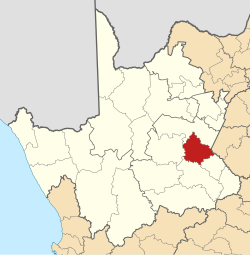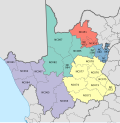Thembelihle | |
|---|---|
 Location in the Northern Cape | |
| Coordinates: 29°45′S 23°45′E / 29.750°S 23.750°E | |
| Country | South Africa |
| Province | Northern Cape |
| District | Pixley ka Seme |
| Seat | Hopetown |
| Wards | 6 |
| Government | |
| • Type | Municipal council |
| • Mayor | Leonard Makena[1] (EFF) |
| Area | |
| • Total | 8,023 km2 (3,098 sq mi) |
| Population (2011)[3] | |
| • Total | 15,701 |
| • Density | 2.0/km2 (5.1/sq mi) |
| Racial makeup (2011) | |
| • Black African | 15.2% |
| • Coloured | 70.7% |
| • Indian/Asian | 0.5% |
| • White | 13.1% |
| First languages (2011) | |
| • Afrikaans | 90.4% |
| • Xhosa | 5.1% |
| • English | 1.3% |
| • Tswana | 1.3% |
| • Other | 1.9% |
| Time zone | UTC+2 (SAST) |
| Municipal code | NC076 |
Thembelihle Municipality (Afrikaans: Thembelihle Munisipaliteit), formerly known as Oranje-Karoo Municipality, is a local municipality within the Pixley ka Seme District Municipality, in the Northern Cape province of South Africa. Thembelihle is a Xhosa word meaning "good hope".[5]
History
At the end of the apartheid era, in the area that is today the Thembelihle Municipality, there were municipal councils for Hopetown and Strydenburg which were elected by the white residents, while the coloured residents of Steynville (Hopetown) and Strydenburg were governed by management committees subordinate to the white councils. The remaining rural areas were served by the Bo-Karoo Regional Services Council.
After the national elections of 1994 a process of local government transformation began, in which negotiations were held between the existing local authorities, political parties, and local community organisations. As a result of these negotiations, the existing local authorities were dissolved and transitional local councils (TLCs) were created for each town. The Strydenburg municipality and management committee were replaced by a TLC in September 1994, and the Hopetown municipality and Steynville management committee were replaced by a TLC in March 1995. The transitional councils were initially made up of members nominated by the various parties to the negotiations, until May 1996 when elections were held. At these elections the Bo-Karoo District Council was established, replacing the Bo-Karoo Regional Services Council. Transitional representative councils (TRCs) were also elected to represent the areas not included in the TLCs on the District Council; the area that was to become Thembelihle Municipality was part of the Oranje-Karoo TRC, except for Orania which had a separate TRC.
At the local elections of December 2000 the TLCs and TRCs were dissolved and the Oranje-Karoo Municipality (renamed Thembelihle in June 2001) was established as a single local authority. The Orania TRC challenged its dissolution in the Kimberley High Court, and under a settlement with the provincial government this TRC retained its powers and functions indefinitely pending further negotiations.[6][7] Orania residents are entitled to vote in elections for the Thembelihle council, and 21% of registered voters in Orania cast a ballot in the 2021 elections,[8] but as of 2016[update] they did not receive any municipal services from Thembelihle.[6]
Geography
The municipality covers an area of 8,023 square kilometres (3,098 sq mi) on the left (south) bank of the Orange River, approximately 130 kilometres (80 mi) south of the provincial capital Kimberley. In the census of 2011 it had a reported population of 15,701 inhabitants in 4,140 households, giving a population density of 1.96 inhabitants per square kilometre (5.1/sq mi).[9] The principal town is Hopetown (pop. 10,259), which is situated on the Orange River. Other settlements are Strydenburg (pop. 2,987) situated 50 kilometres (30 mi) to the south-west of Hopetown, and Orania (pop. 2,377 at 2021) situated on the Orange River 35 kilometres (22 mi) to the south-east of Hopetown. The remainder of the municipality is rural, mostly used for farming of sheep and goats while intensive irrigated agriculture occurs along the Orange River. The main transport links in the municipal area are the N12 national road and the De Aar–Kimberley railway line, both of which pass north-south through the municipality.
According to the census, the main spoken language in the municipality is Afrikaans, which is home language of 89% of residents. It is followed by isiXhosa (5%), English and Setswana (1% each). 71% of residents identified themselves as Coloured, 15% as Black African, and 13% as White. 31% of residents were under the age of 15.[9]
Politics
The municipal council consists of eleven members elected by mixed-member proportional representation. Six councillors are elected by first-past-the-post voting in six wards, while the remaining three are chosen from party lists so that the total number of party representatives is proportional to the number of votes received.
For most of the time since its creation in 2000 Thembelihle has been governed by the African National Congress (ANC), which won outright majorities in the 2000, 2006 and 2011 municipal elections. The opposition took control of the council in December 2011, however, after ANC lost a by-election to an independent candidate. The independent, former ANC member Danny Jonas, became the new mayor of the municipality supported by the Congress of the People and the Democratic Alliance.[10] Jonas later joined the Economic Freedom Fighters (EFF).
In the election of 3 August 2016 the ANC regained control of the municipality, winning a majority of four seats on the council.
The following table shows the results of the 2021 election.[11][12]
| Thembelihle local election, 1 November 2021 | ||||||||
|---|---|---|---|---|---|---|---|---|
| Party | Votes | Seats | ||||||
| Ward | List | Total | % | Ward | List | Total | ||
| African National Congress | 2,186 | 2,157 | 4,343 | 39.8% | 4 | 1 | 5 | |
| Economic Freedom Fighters | 1,315 | 1,362 | 2,677 | 24.5% | 1 | 2 | 3 | |
| Democratic Alliance | 627 | 705 | 1,332 | 12.2% | 0 | 1 | 1 | |
| Freedom Front Plus | 551 | 470 | 1,021 | 9.4% | 1 | 0 | 1 | |
| Siyathemba Community Movement | 152 | 557 | 709 | 6.5% | 0 | 1 | 1 | |
| Independent candidates | 462 | – | 462 | 4.2% | 0 | – | 0 | |
| Patriotic Alliance | 103 | 117 | 220 | 2.0% | 0 | 0 | 0 | |
| African Christian Democratic Party | 69 | 75 | 144 | 1.3% | 0 | 0 | 0 | |
| Total | 5,465 | 5,443 | 10,908 | 6 | 5 | 11 | ||
| Valid votes | 5,465 | 5,443 | 10,908 | 98.4% | ||||
| Spoilt votes | 91 | 86 | 177 | 1.6% | ||||
| Total votes cast | 5,556 | 5,529 | 11,085 | |||||
| Voter turnout | 5,562 | |||||||
| Registered voters | 9,386 | |||||||
| Turnout percentage | 59.3% | |||||||
References
- ^ "EFF mayor elected in Northern Cape municipality, which includes Orania". The South African. 2021-11-26. Retrieved 2022-04-18.
- ^ "Contact list: Executive Mayors". Government Communication & Information System. Archived from the original on 14 July 2010. Retrieved 22 February 2012.
- ^ a b "Statistics by place". Statistics South Africa. Retrieved 27 September 2015.
- ^ "Statistics by place". Statistics South Africa. Retrieved 27 September 2015.
- ^ South African Languages - Place names
- ^ a b De Wet, Phillip (5 August 2016). "Orania held its own election this week, buoyed by a vision of growth and prosperity". Mail & Guardian. Retrieved 10 April 2022.
- ^ Cavanagh, Edward (2013). Settler Colonialism and Land Rights in South Africa: Possession and Dispossession on the Orange River. Palgrave Macmillan. p. 82. ISBN 9781137305763.
- ^ "Results Summary - All Ballots: Voting District 65320017" (PDF). Electoral Commission. Retrieved 10 April 2022.
- ^ a b "Thembelihle". Stats SA. Retrieved 11 April 2022.
- ^ "By-elections: The DA and Cope learn how to steal ANC marbles by and by". 9 December 2011.
- ^ "Results Summary - All Ballots" (PDF). Electoral Commission of South Africa. 8 November 2021. Retrieved 12 November 2021.
- ^ "Seat Calculation Detail" (PDF). Electoral Commission of South Africa. 8 November 2021. Retrieved 12 November 2021.



